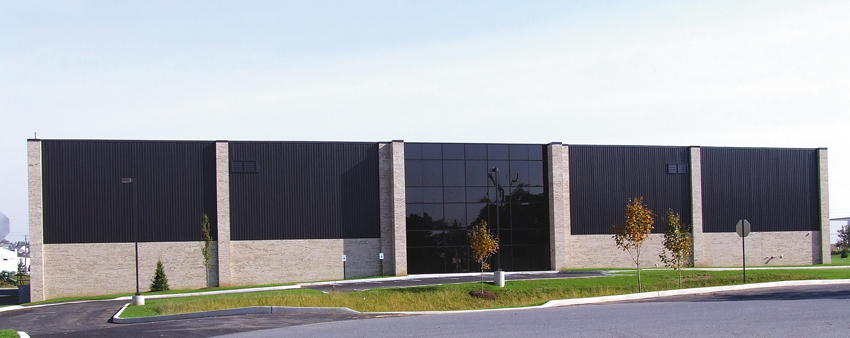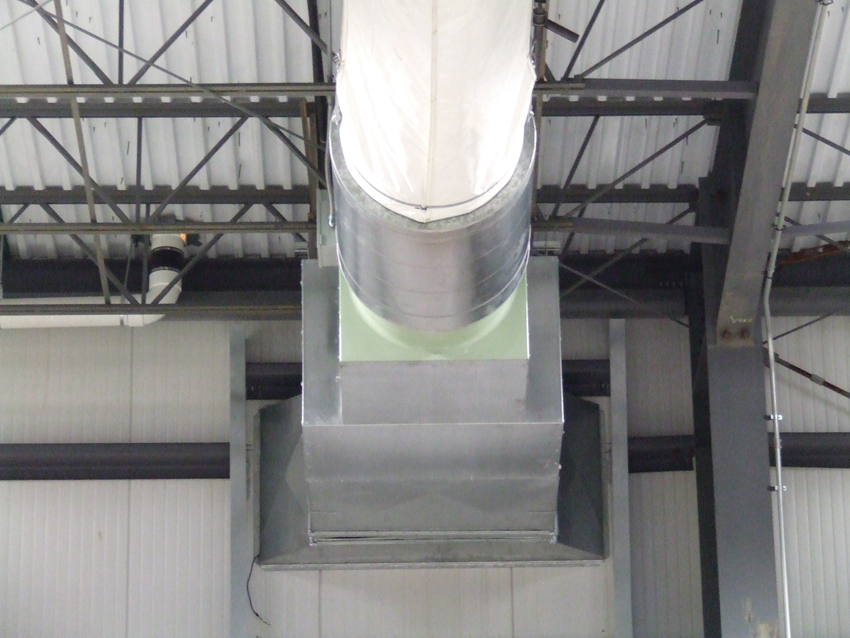This CE Center article is no longer eligible for receiving credits.
We humans have put more planet-warming carbon into the atmosphere in the past 30 years than we had in all of human history up until that point. Many believe recent climate events demonstrate that if we do not preserve the delicate balances in the natural world that make life here possible, we are risking our very existence.
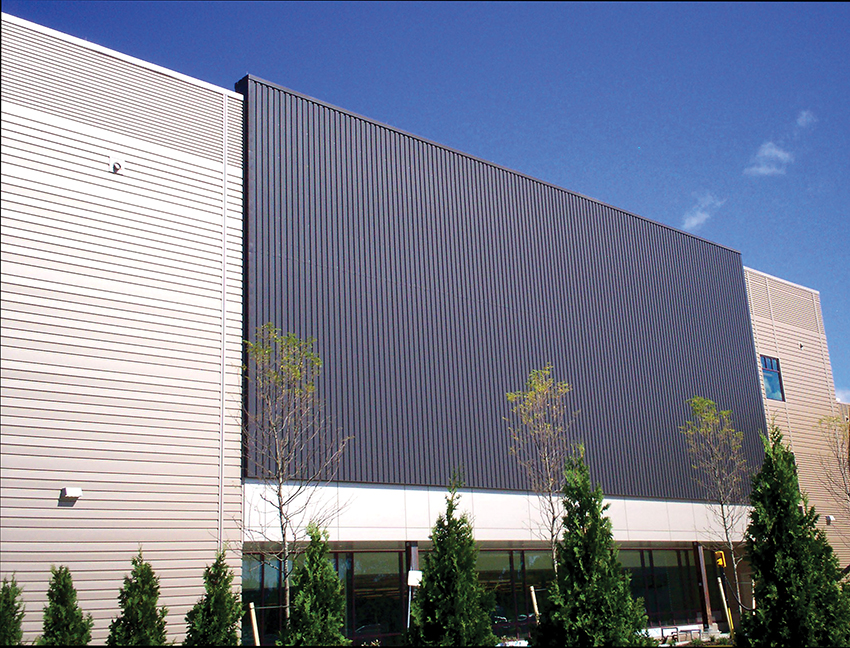
All images courtesy of ATAS International, Inc.
Transpired solar-collector panels attached over any exterior, noncombustible, weathertight wall provide a building with preheated ventilation air.
Of all the greenhouse gas emissions released into the atmosphere, some 30–40 percent of them comes from the built environment. The energy needed to ventilate, heat, and cool the air inside of buildings is responsible for a significant portion of these emissions. Experts in the design, engineering, and construction professions believe with growing intensity that creating a built environment in harmony with nature is critical for our survival.
Such is the power of metal features in building envelopes that exploit the natural forces of physics, of air and energy flow, to heat and cool buildings. This course illustrates the intelligence of specifying transpired metal walls that preheat fresh air in winter prior to intake, cool roofing in cooling climates, and roofing that is solar ready. Not to be underestimated is the tremendous potential for LEED v4 points when designing a smart building envelope with metal features. We will begin with the surprisingly simple yet profoundly effective energy-saving strategy of installing transpired solar collectors on a building wall.
Transpired Solar Collectors: Low Tech, High Impact
The phrase “transpired solar collector” may sound complex, but it is an ingeniously uncomplicated and straightforward energy-saving building system. A U.S. Department of Energy Federal Technology Alert titled “Transpired Collectors (Solar Preheaters for Outdoor Ventilation Air),” states that “transpired collectors are a renewable energy technology that is well proven” plus is “readily available and has considerable potential” for many applications.1 A transpired solar-collector system is used to preheat outside air before it enters the building to provide fresh-air changes and natural dehumidification. As a result, it offers opportunities to reduce energy consumption in the built environment.
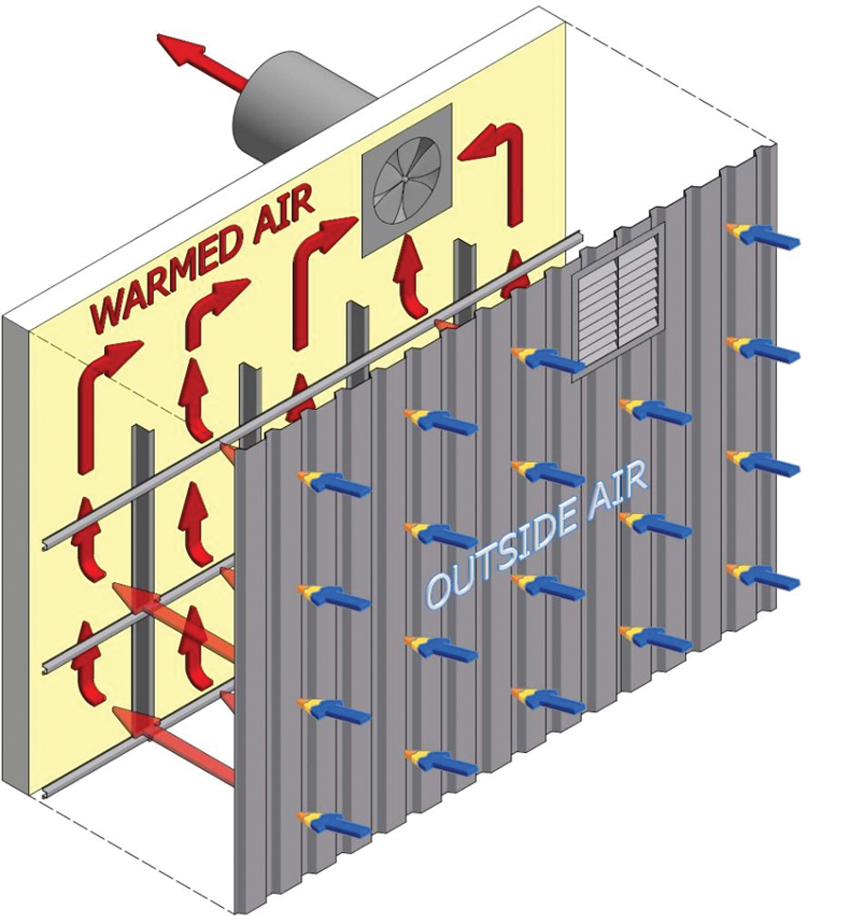
The outside air is heated by the sun and then drawn through the perforations into the plenum. The air is further heated as it passes by the edges of the openings. It is warmed even more inside of the plenum, and then the warmed air is drawn into the building.
Here is the concept: A transpired solar collector is a perforated metal wall panel (on the market, aluminum, zinc, steel, and polycarbonate are found) that is usually mounted onto the south-facing exterior of a building (though mounts on southeast and southwest walls are also adequate to provide preheated air). The precision perforations in the wall panels allow for outside air to travel through the face of the panel. When the metal panel is exposed to sunlight, it heats up, which creates a layer of warm air on the surface of the panel. This solar-heated air is then drawn through the perforations, where it rises between the two walls and enters the building’s central ventilation system or supply fan, where it is then distributed through the building’s duct work.

Precision-lanced perforations allow heated outdoor air to enter the gap between the building’s outer wall and metal panels.
Imagine a brisk winter day with an ambient temperature of 20 degrees Fahrenheit. Now imagine that the air entering the building’s air-handling system is not 20 degrees but instead has been preheated by the transpired solar collectors and is a relatively toasty 40, 50, or even 60 degrees depending on various factors, including instantaneous solar radiation, airflow through the collector, and outside wind conditions. The preheated ventilation air entering the building will result in a major reduction of energy use.
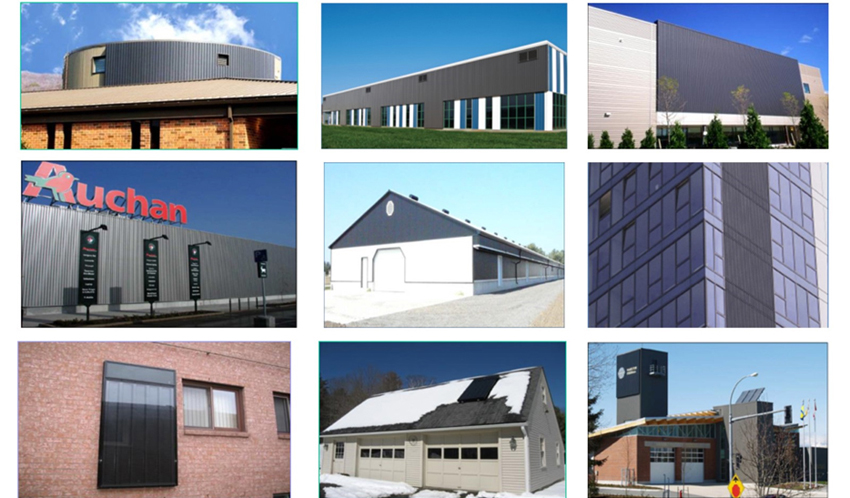
Shown are the types of buildings that can benefit from transpired solar systems.
In summer, the same transpired panels perform as insulation, preventing the full force of solar heat from reaching the wall. However, in this season, the heated air created in the plenum bypasses the building’s air-handling system and is released into the atmosphere, keeping the building cooler.
A Technology Developed by NREL
Transpired solar collectors were developed in 1989 by the National Renewable Energy Lab (NREL), as well as being developed concurrently by private researchers.
Prior to 1989, the Federal Technology Alert on transpired collectors explains,
“Solar air-heating systems resembled flat-plate water-heating systems. These early systems contained a dark metal absorber, but they also had glazing—a transparent cover—that prevented heat loss to the atmosphere. Rather than pull air through the absorber, these systems heated the air flowing parallel to the absorber. Compared to transpired collector technology, these systems were less efficient because solar radiation was reflected off of the glazing, and they had comparatively poor heat transfer from the absorber to the air. They were also more expensive because of the added material cost as well as installation.”2
Once the glazing was removed and perforations added, the system to heat intake air took on new efficacy, with higher efficiency and lower costs.

Installation of the transpired solar system does not require special skills or tools.
Almost Unlimited Application Potential
Transpired solar collectors are used for a variety of applications, including:
- Schools K–12
- Higher-education facilities
- Office buildings
- Medical facilities
- Government buildings
- Military facilities
- High-rise apartments
- Mixed-use facilities
- Shopping centers
- Industrial/manufacturing facilities
- Warehouses
- Agricultural buildings
- Residential (small-space heating)
How the Systems Are Installed
Transpired solar-collector panels can be installed over any noncombustible wall material and over or around existing wall openings. These systems offer ease of installation, as they do not require any special tools or skills.
First, light-gauge framing members (vertical Z-sections and horizontal hats) are attached to the wall. The perforated aluminum or zinc panels are then attached to the framing, creating an offset or a plenum. Panels are typically installed 4–8 inches from the wall, as determined through an engineering study.
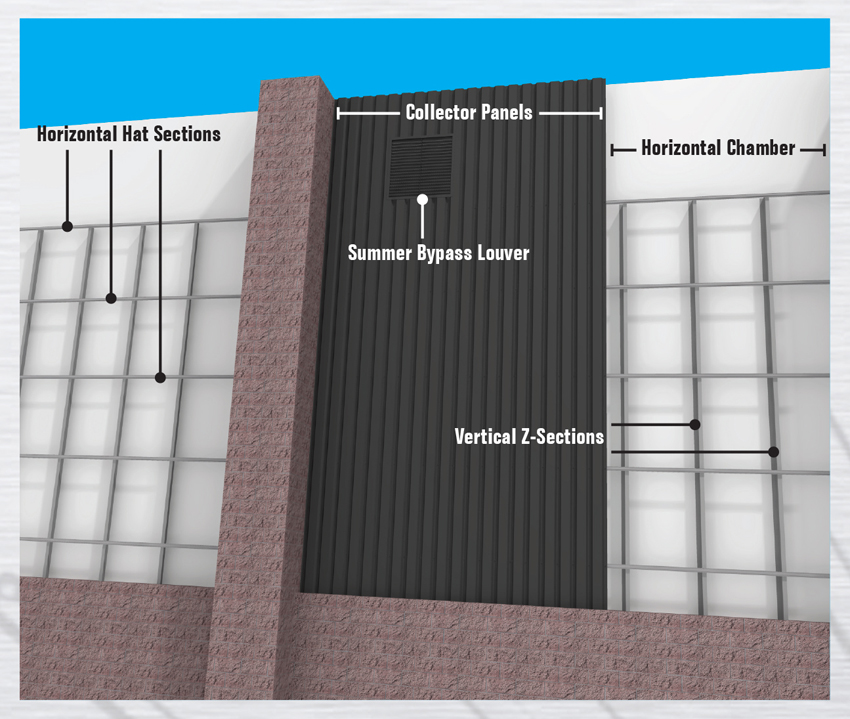
This is a typical collector panel installation showing the horizontal hat sections, vertical Z-sections, and horizontal chamber.
We humans have put more planet-warming carbon into the atmosphere in the past 30 years than we had in all of human history up until that point. Many believe recent climate events demonstrate that if we do not preserve the delicate balances in the natural world that make life here possible, we are risking our very existence.

All images courtesy of ATAS International, Inc.
Transpired solar-collector panels attached over any exterior, noncombustible, weathertight wall provide a building with preheated ventilation air.
Of all the greenhouse gas emissions released into the atmosphere, some 30–40 percent of them comes from the built environment. The energy needed to ventilate, heat, and cool the air inside of buildings is responsible for a significant portion of these emissions. Experts in the design, engineering, and construction professions believe with growing intensity that creating a built environment in harmony with nature is critical for our survival.
Such is the power of metal features in building envelopes that exploit the natural forces of physics, of air and energy flow, to heat and cool buildings. This course illustrates the intelligence of specifying transpired metal walls that preheat fresh air in winter prior to intake, cool roofing in cooling climates, and roofing that is solar ready. Not to be underestimated is the tremendous potential for LEED v4 points when designing a smart building envelope with metal features. We will begin with the surprisingly simple yet profoundly effective energy-saving strategy of installing transpired solar collectors on a building wall.
Transpired Solar Collectors: Low Tech, High Impact
The phrase “transpired solar collector” may sound complex, but it is an ingeniously uncomplicated and straightforward energy-saving building system. A U.S. Department of Energy Federal Technology Alert titled “Transpired Collectors (Solar Preheaters for Outdoor Ventilation Air),” states that “transpired collectors are a renewable energy technology that is well proven” plus is “readily available and has considerable potential” for many applications.1 A transpired solar-collector system is used to preheat outside air before it enters the building to provide fresh-air changes and natural dehumidification. As a result, it offers opportunities to reduce energy consumption in the built environment.

The outside air is heated by the sun and then drawn through the perforations into the plenum. The air is further heated as it passes by the edges of the openings. It is warmed even more inside of the plenum, and then the warmed air is drawn into the building.
Here is the concept: A transpired solar collector is a perforated metal wall panel (on the market, aluminum, zinc, steel, and polycarbonate are found) that is usually mounted onto the south-facing exterior of a building (though mounts on southeast and southwest walls are also adequate to provide preheated air). The precision perforations in the wall panels allow for outside air to travel through the face of the panel. When the metal panel is exposed to sunlight, it heats up, which creates a layer of warm air on the surface of the panel. This solar-heated air is then drawn through the perforations, where it rises between the two walls and enters the building’s central ventilation system or supply fan, where it is then distributed through the building’s duct work.

Precision-lanced perforations allow heated outdoor air to enter the gap between the building’s outer wall and metal panels.
Imagine a brisk winter day with an ambient temperature of 20 degrees Fahrenheit. Now imagine that the air entering the building’s air-handling system is not 20 degrees but instead has been preheated by the transpired solar collectors and is a relatively toasty 40, 50, or even 60 degrees depending on various factors, including instantaneous solar radiation, airflow through the collector, and outside wind conditions. The preheated ventilation air entering the building will result in a major reduction of energy use.

Shown are the types of buildings that can benefit from transpired solar systems.
In summer, the same transpired panels perform as insulation, preventing the full force of solar heat from reaching the wall. However, in this season, the heated air created in the plenum bypasses the building’s air-handling system and is released into the atmosphere, keeping the building cooler.
A Technology Developed by NREL
Transpired solar collectors were developed in 1989 by the National Renewable Energy Lab (NREL), as well as being developed concurrently by private researchers.
Prior to 1989, the Federal Technology Alert on transpired collectors explains,
“Solar air-heating systems resembled flat-plate water-heating systems. These early systems contained a dark metal absorber, but they also had glazing—a transparent cover—that prevented heat loss to the atmosphere. Rather than pull air through the absorber, these systems heated the air flowing parallel to the absorber. Compared to transpired collector technology, these systems were less efficient because solar radiation was reflected off of the glazing, and they had comparatively poor heat transfer from the absorber to the air. They were also more expensive because of the added material cost as well as installation.”2
Once the glazing was removed and perforations added, the system to heat intake air took on new efficacy, with higher efficiency and lower costs.

Installation of the transpired solar system does not require special skills or tools.
Almost Unlimited Application Potential
Transpired solar collectors are used for a variety of applications, including:
- Schools K–12
- Higher-education facilities
- Office buildings
- Medical facilities
- Government buildings
- Military facilities
- High-rise apartments
- Mixed-use facilities
- Shopping centers
- Industrial/manufacturing facilities
- Warehouses
- Agricultural buildings
- Residential (small-space heating)
How the Systems Are Installed
Transpired solar-collector panels can be installed over any noncombustible wall material and over or around existing wall openings. These systems offer ease of installation, as they do not require any special tools or skills.
First, light-gauge framing members (vertical Z-sections and horizontal hats) are attached to the wall. The perforated aluminum or zinc panels are then attached to the framing, creating an offset or a plenum. Panels are typically installed 4–8 inches from the wall, as determined through an engineering study.

This is a typical collector panel installation showing the horizontal hat sections, vertical Z-sections, and horizontal chamber.
Connections
In an industrial application, solar-heated air is supplied directly to the building via a perforated flexible duct. In open-ceiling spaces, buildings, or halls, ducting destratifies ceiling heat, thereby reducing heating loads.
In a high-occupancy building, such as an office, school, or medical facility, the solar-heated air is ducted directly to the HVAC air handler, thus reducing loads on the conventional heater. Additionally, the system can be connected to an air makeup or heat-recovery unit.
As a versatile technology, the transpired solar-collector system works with most mechanical designs, making it appropriate for both new and retrofit applications. An HVAC engineer should consider solar air as simply an additional heat source that needs to be managed and controlled in an optimal way.
Heating Season: Industrial Application
In cooler months, the role of the heating system is to compensate for the thermal losses through the building’s envelope. Heating loads become very important when ventilation outside air must be heated. This is where transpired solar collectors come into play.
The use of solar-collector panels facilitates healthy indoor air quality, reduces heating consumption for ventilation, and can lower heating costs by $1.50–$5.50 per square foot of panel per year. Reduction is dependent upon several factors, including displaced fuel cost, ventilation schedule, and color of the transpired solar-collector panels.
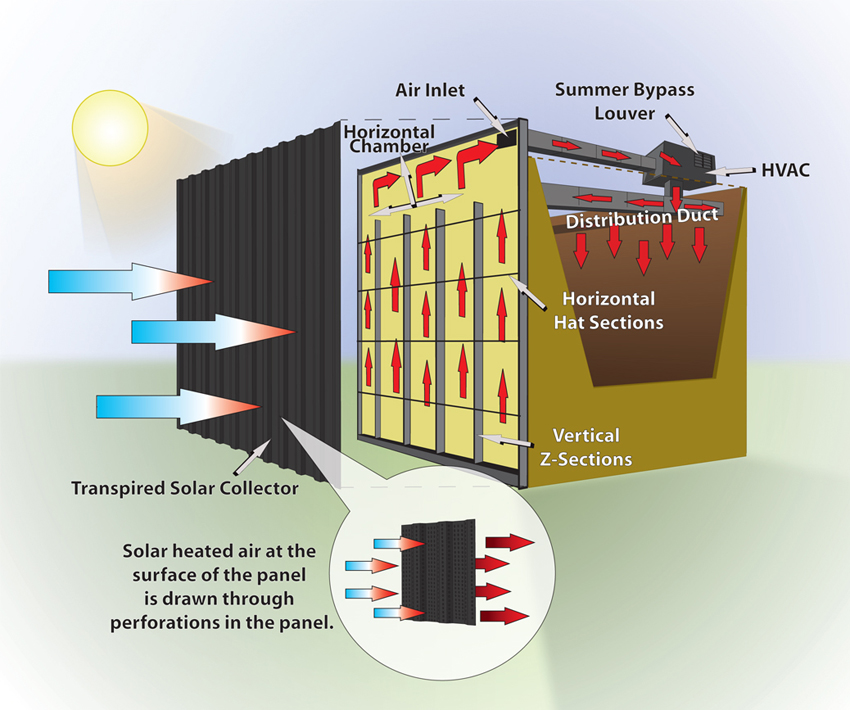
This shows the system for a high-occupancy application, such as a school or office building. In this case, the warmed air is ducted to the building’s regular air-handling system, usually a makeup air unit or rooftop air handler.
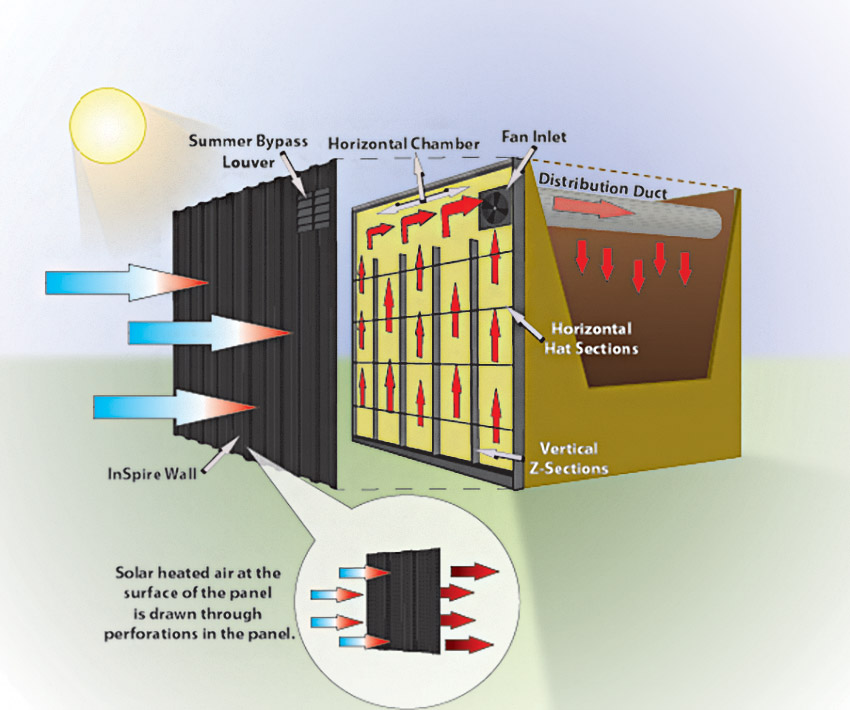
This shows an industrial application in the heating season where the warmed outside air is brought directly into the building via a perforated distribution fabric air duct attached to the stand-alone fan. From there, the warm air is either distributed into the building when needed or sent back into the environment by a bypass damper if warm air is not required at the time.
Cooling Season: Daytime and Nighttime
Solar-collector panels help to reduce the cooling load in the summer months.
During cooling season, the solar-collector panels act as a sunscreen, preventing the sunshine from striking the building wall and keeping the wall cooler.
Since the building does not require heat at this time of year, the warm air enters the space behind the panel and is vented at the top by natural convection. During cool summer nights, the intake fan pulls outside air through the perforated wall and past the open bypass damper, bringing cooler outdoor air inside.
Heat Stratification
Another benefit of a transpired solar-collector system is heat destratification, which is the process of mixing the internal air in a building to get rid of stratified layers of air and thus achieve equal temperature throughout the inside of the building envelope.
Why is this significant? Thermal layering of air creates significant heating inefficiencies, especially in buildings with high ceilings. Naturally the warmest layer of air is near the ceiling, but so are the exhaust fans. These exhaust fans create a negative pressure near the ceiling, causing cold air to infiltrate the building near ground level while the warmest air gets exhausted out of the building. This is a waste of energy.
By drawing warm air through the transpired solar-collector wall and into the distribution duct, the process is reversed. In other words, it is destratified.
Increasing the internal air pressure toward the ceiling forces the solar-heated air to move toward floor level. This can be particularly noticeable when doors are opened, especially large roll-up cargo doors.
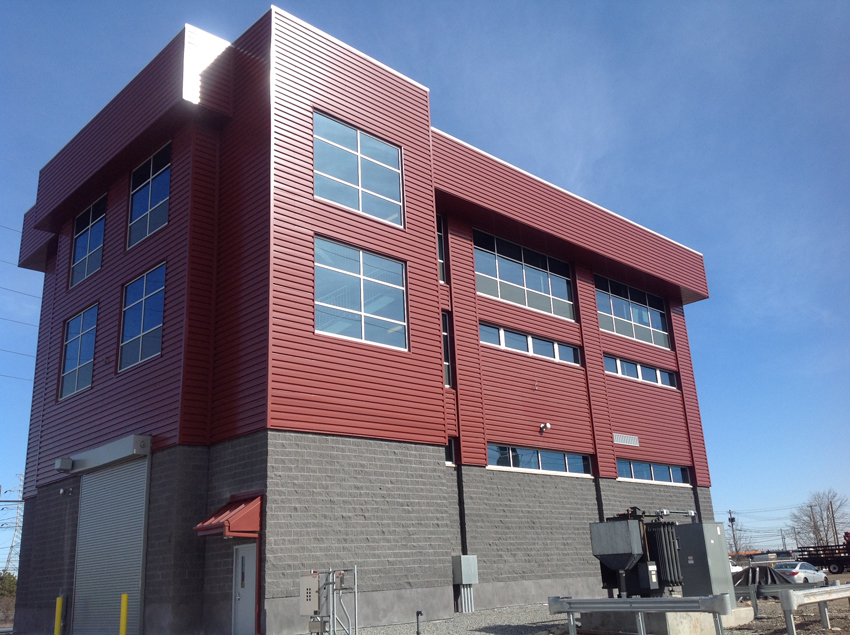
While the most commonly used colors for transpired solar panels are higher-efficiency black or dark brown for their heat-absorption properties, many other colors can also be specified.
Design Flexibility
Because of the simple nature of the technology, transpired solar-collector systems offer robust design flexibility, so the designer is not locked into a particular orientation that may not fit the design aesthetic. The panels may be oriented horizontally or vertically and feature mitered corners and concealed fasteners. To meet a range of aesthetic objectives, solar-collector panels come in a wide variety of colors and profiles.
Naturally, the most commonly used colors are black or dark brown, as they work best for heat absorption. However, many other colors can be specified for these systems, with the caveat that they will produce a slightly lower BTU or heat output.
A complete line of trims is generally available in matching colors, gauges, and finishes, or as specified, depending on the manufacturer. The panel system can integrate with windows and doors, so an unbroken wall surface is not necessary. Transpired walls can be designed for radius walls as well.
Costs and Rebates
Generally, the payback period for a commercial application of a transpired solar-collector system ranges from zero to eight years in new projects and three to 10 years in retrofit applications. However, that time frame varies a great deal based primarily on the cost of fuel for the building’s primary heat source.
A favorable tax environment enhances the financial feasibility of transpired solar-collector technology. For commercial projects, a 26 percent federal tax credit is available for solar space heating projects placed in service through December 31, 2020, and a 22 percent federal tax credit is available for systems placed in service through December 31, 2021.3
Plus, some states offer their own tax incentives, rebates, grants, and loans (visit www.dsireusa.org for more information).
Sustainability
Transpired solar-collector systems have green building benefits, including:
- Convert up to 80 percent of the sun’s radiation into non-polluting warm air
- Recapture heat loss through building walls
- Provide insulating effect on building inner wall
- Utilize hot stratified air trapped at ceilings
- Lower the temperature of air exhausted through the roof
- Reduce energy consumption and greenhouse gas emissions
- Shield the inner wall from direct sunlight during summer
- Provide a cost-effective way to meet code requirements for ventilation
- Deliver improved indoor air quality and reduce the risk of sick building syndrome
- Require virtually no maintenance
- May contribute toward LEED certification credits
LEED v4: Potential Contribution of Transpired Solar Collector
- Integrative Process Credit (1 point)
- Minimum Energy Performance (prerequisite)
- Optimize Energy Performance (up to 18 points)
- Renewable Energy Production (up to 3 points)
- Building Life-Cycle Impact Reduction (up to 5 points)
- Thermal Comfort Credit (1 point)
- Innovation Credit (up to 5 points)
It is likely the use of transpired solar collectors will eventually be a common building system feature. According to the NREL report, “The future will likely see increased use of transpired collectors in the federal and private sectors. The biggest hurdle the technology must overcome is user acceptance. Many solar technologies have been stigmatized by the rapid expansion of solar markets in the 1970s, when many poorly designed and poorly performing systems were deployed. Many potential users are reluctant to commit to a solar technology if a proven conventional option is available. Transpired collector technology has been proven to be valid and reliable for reducing energy use and saving money, and the body of scientific data proving its effectiveness continues to grow.”
The report continues: “Transpired collectors are among the most efficient solar collectors available, converting 65–75 percent of the available solar energy. “
Cutting-Edge Cool Roof and Wall Technologies for Cooling Climates
Benefits and features of cool metal roofing include:
- Energy efficiency
- Sustainability
- Low life-cycle costs
- Durability
- Fire and wind resistance
- Light weight
Science Behind Cool Roofs: Solar Reflectance, Absorption, and Emittance
When sunlight strikes a surface, in terms of energy, there are three outcomes as follows.
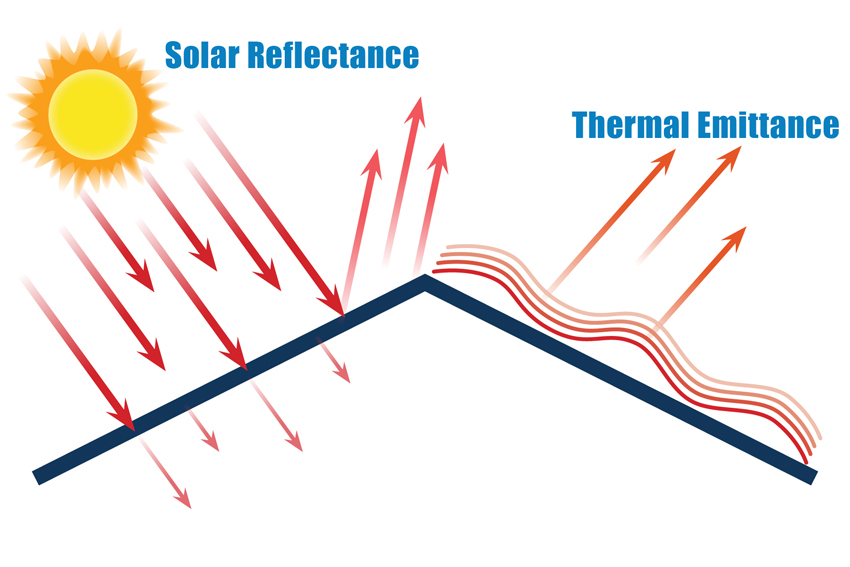
The science behind cool roofs must begin with a discussion on solar reflectance, absorption, and thermal emittance.
Solar reflectance: Some solar energy will immediately reflect off of the surface. This is expressed as a decimal, 0.65, meaning that 65 percent of solar radiation is immediately reflected.
Absorption: The energy that is not reflected will be absorbed by the material, causing it to heat up. Some heat can be removed by airflow over the surface, as with the use of above-sheathing ventilation (discussed later in the article). Some heat will be conducted through the roof surface into the building.
Thermal emittance: This is expressed as a decimal, such as 0.90. Thermal emittance refers to the percent of absorbed energy that is emitted as thermal infrared (IR) energy into the night air. Materials with high thermal emittance cool down faster than those with low thermal emittance.
Solar Reflectance Index
It is the combination of solar reflectance and thermal emittance that determines the surface temperature of a roof and its ability to be a “cool roof.”
The solar reflectance index (SRI) is calculated using values for solar reflectance and emissivity. The SRI allows us to compare the ability of a material to reject solar heat. Here are the calculations:
- Standard black with a reflectance of 0.05 and emittance of 0.90 = 0 SRI
- Standard white with a reflectance of 0.80 and emittance of 0.90 = 100 SRI
The SRI can be calculated by interpolating between the values for white and black. Materials with the highest SRI values are the coolest choices for a metal roof.
Painted Metal Roofs/Unpainted Metal Roofs
Roofs that are highly reflective and highly emissive, such as pre-painted metal with appropriate colors, offer a system that significantly reduces heat gain into the building.
When evaluating the cooling potential for painted metal, reflectance depends on two factors: color and pigmentation.
- Color: Light colors reflect more heat than dark colors; dark colors absorb more heat than light colors.
- Pigmentation: This refers to the chemistry of the paint itself. Today’s pigments are designed to be highly reflective, and that applies to dark colors as well as light colors.
In warmer climates where cooling requirements dominate, a high reflectance and emittance is desirable, which can be met with a pre-painted metal roof using lighter colors and/or reflective pigmentation. For every 1 percent increment in roof reflectance, the surface temperature decreases 1 degree Fahrenheit. For every 10 percent increase in roof reflectance, heating and cooling costs drop 2 cents per square foot per year.
In cooler climates where heating dominates, it may still be desirable to reduce peak energy demands during the summer months with cool roofing technology. Heating penalties may be offset through above sheathing ventilation, to be discussed later in the article.
The Potential for Cool Walls Should Not Be Overlooked
A study of cool walls by scientists at the U.S. Department of Energy’s Lawrence Berkeley National Laboratory (Berkeley Lab) was based on models of different types and ages of homes, office buildings, and retail stores in locations throughout California and the United States.4
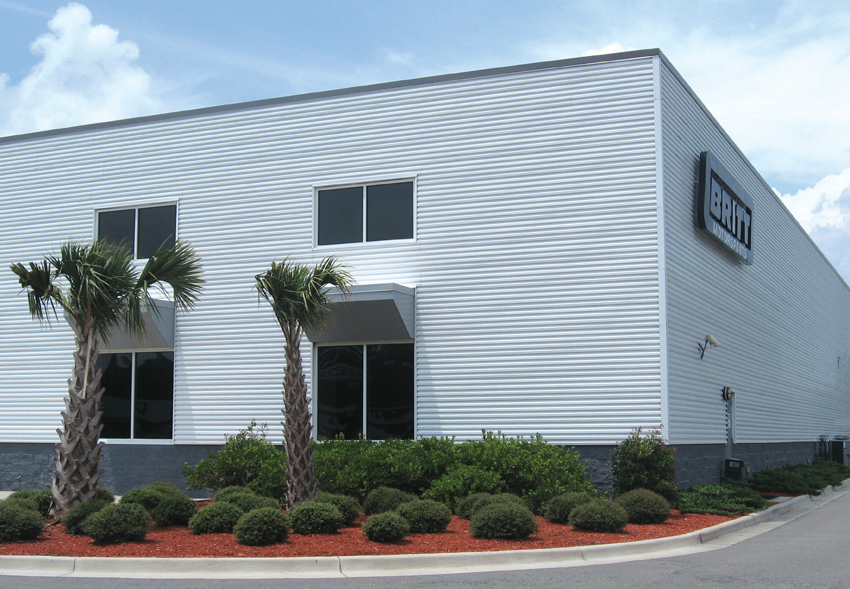
While cool roofs have rightly become intelligent strategies to keep buildings cool and to prevent the urban heat island effect, cool walls have gotten less attention than they should. In fact, cool metal walls can deliver significant energy-saving benefits.
The study, titled “Potential benefits of cool walls on residential and commercial buildings across California and the United States: Conserving energy, saving money, and reducing emission of greenhouse gases and air pollutants,” was published in 2019 in the journal Energy and Buildings.5
The findings indicate that in many locations, sunlight-reflecting cool exterior walls can save as much or more energy than sunlight-reflecting cool roofs. And these cool walls can help mitigate the urban heat island effect.
For the project, the scientists studied more than 100,000 building simulations. Berkeley Lab maintains a separate Heat Island Group that explores the increase in outdoor urban air temperatures stemming from the concentration of buildings, roads, and other structures that absorb heat, and it studies methods to minimize the problem.
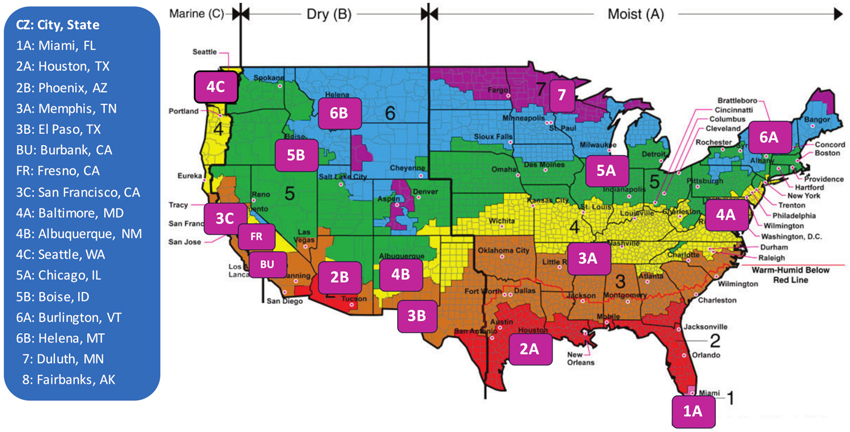
Source: Solar-Reflective “Cool” Walls: Benefits, Technologies, and Implementation, Appendix P, California Energy Commission.
Cool walls create multiple benefits in California and the southern part of the United States.
Based on the models for warm U.S. cities from Miami, Florida, to Albuquerque, New Mexico, researchers found that cool walls could lead to annual heating, ventilation, and air-onditioning (HVAC) energy cost savings up to:
- 11 percent for stand-alone retail stores;
- 8.3 percent for single-family homes;
- 4.6 percent for medium-sized office buildings; and
- 4–27 percent for single-family homes in all of California.
The researchers discovered that cool walls offer reductions in annual emissions of nitrogen oxides, sulfur dioxide, and greenhouse gases such as carbon dioxide. In addition, cool walls lower peak demand for electric power, which is an increasingly important factor in sustainability goals for green developments.
Ronnen Levinson, leader of the Berkeley Lab’s Heat Island Group and co-author of the study, was quoted as saying: “Cool walls provide energy cost savings and emission reductions across California and the southern half of the United States. In these climates, cool walls can save as much or more energy than the same-size cool roof.” The reason, he explained, is that while walls receive less intense sunlight than roofs, they are also less insulated.
LEED v4: Potential Contribution of Metal Roofing and/or Walls
- Integrative Process (1 point)
- Heat Island Reduction (up to 2 points)
- Rain Water Management (up to 2 points)*
- Outdoor Water Use Reduction (up to 2 points)*
- Indoor Water Use Reduction (up to 6 points)*
- Minimum Energy Performance (prerequisite)
- Optimize Energy Performance (up to 18 points)
- Building Life-Cycle Impact Reduction (up to 5 points)
- Thermal Comfort (1 point)
*Note that metal roofing is an ideal choice for rainwater harvesting applications. The water collected can be used for outdoor use in landscape irrigation, and for indoor use in a building’s greywater system
Above-Sheathing Ventilation (ASV)
Another simple, passive technology for cool roofs that exploits the forces of nature is above-sheathing ventilation (ASV). This cool roof installation method creates an airspace between a roofing panel and the deck to allow airflow to exit at the rooftop.
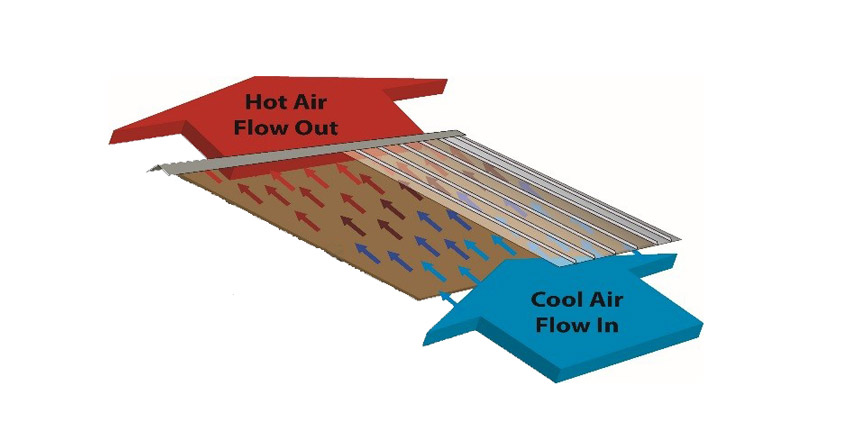
An airspace between the roof deck and the panels creates a path for hot air to rise and escape.
It is interesting to note that in studies, when a 4-inch offset is created between the panel and the deck, the attic temperatures never exceeds peak daytime outdoor temperatures.
However, even smaller airspaces can achieve a significant reduction of heat transfer into the building. In fact, California’s Title 24 currently defines a 1-inch airspace as a standard for determining cool roof ratings, regardless of the color chosen.
ASV is achieved with the use of spacer shims, many of which are designed to be stackable and to provide ventilation spaces in increments, or by creating secondary framing between the primary structure and the roof covering. ASV shims are easy to install between the roof deck and the metal panels, creating offset to ensure continuous airflow between the roof sheathing and the metal panel system. Outside air enters at the eve, is heated, and flows up and out at the ridge, thereby minimizing the effect of condensation between the roof layers.
ASV creates energy savings by reducing air-conditioning costs in the summer and adding insulation value during the winter. In effect, ASV negates heating penalties associated with cool roofing in northern climates by using the airspace as extra insulation.
Research proves the effectiveness of ASV. After testing, the Oak Ridge National Laboratory (ORNL) stated that ASV combined with a cool metal roof can reduce heat gain by up to 45 percent.6 ORNL showed that ASV can produce the equivalent of 0.15 solar reflectance gain and can significantly reduce roofing temperatures so that attic temperatures do not exceed the peak daytime outdoor air temperature.
A variety of ASV profiles of manufactured panels are available that incorporate ASV technology. The combination of product design and installation method naturally creates an airspace beneath the roofing.
ASV can also be created in retrofits when metal roofing is installed over the previous roof system. In addition, new commercial and residential roofing projects can include ASV by specifying an appropriate air gap.
Standards and ASV
Standards back ASV as an effective energy-saving technology. Title 24 California Building Standards Section 152 and NAHB Green Building Standard Chapter 7 state that a roof installed with an appropriate air gap is considered equivalent to the prescriptive definition of a cool roof (cool pigment on metal roof) regardless of its solar reflectance.
Title 24 California Building Standards:
- Section 152, Energy Efficiency Standards for Additions and Alterations in Existing Buildings that will be Low-Rise Residential Occupancies Alterations
- Equivalence: Insulation with a thermal resistance of at least 0.85 hr-ft2-ºF/Btu [R-Value = 0.85] or at least a 1-inch airspace is added to the roof deck over an attic
NAHB Green Building Standard:
- Chapter 7, Energy Efficiency, Section 704.3.1.3 Passive Cooling Design
- 1 point if “roofing material is installed with a minimum 3⁄4-inch (19-millimeter) continuous airspace offset from the roof deck from eave to ridge”
Solar-Ready Roofing
Metal roofs are an excellent platform for photovoltaic (PV) systems. They offer recyclability, strength, and weather resistance, as well as a longer service life compared to other roofing materials. In the Metal Construction Association’s white paper “Benefits of Retrofit Roofing,” research from the Metal Advisory Group reported that mounting a PV system on a sloped metal roof can provide energy savings of 24–43 percent over a conventional roof.7
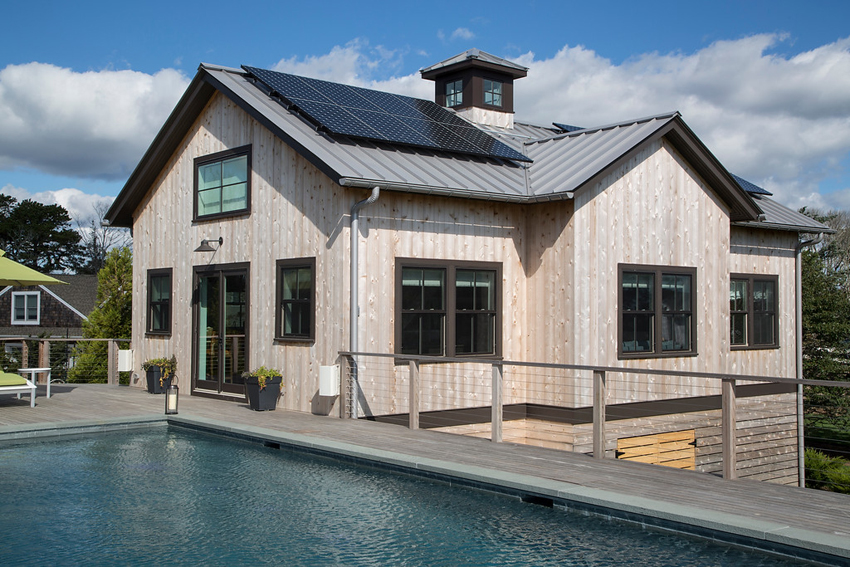
A solar-ready, standing-seam cool metal roof is an ideal platform for solar panels.
To promote energy independence and the reduction of carbon dioxide emissions, federal, state, and utility incentives may be available for the installation and operation of photovoltaic systems.
PV systems work with net metering that tracks both the electricity consumed on-site and the electricity generated by the PV system. The energy collected by the solar panels is channeled to an inverter that changes the DC electricity to AC electricity for building use. AC electricity that is not immediately used by the building can be directed into the local grid. This may result in a credit from the utility company, causing the meter to spin backward. When electricity is required, it is drawn from the power company grid, and the meter spins forward.
There are two basic types of photovoltaics: crystalline and building integrated photovoltaic (BIPV).
Crystalline Solar Panels
The major share of the market is made up of crystalline modules. They are the types of panels that you typically see on rooftops or ground-mounted in fields.
Crystalline panels offer the highest efficiency for converting sunlight into electricity. They can be attached onto standing-seam metal roof panels with easy-to-install clips. No penetrations are needed for attachment; therefore, there are no issues with water infiltration, plus the roof warranty remains intact.
Conversely, conventional membrane or ballasted roofs often use racking for PV systems. In many cases, the racks need to be secured into the structural system of the roof. This requires penetrations through the roof, which can be potential areas for leaks. The main issue, however, is that the PV service life is more than that of the various conventional roof membranes. As a result, when the roof has to be replaced, decommissioning the solar system may dramatically increase costs of the roof replacement.
Building Integrated Photovoltaic (BIPV)
BIPV systems (also referred to as thin-film laminates) are complete, pre-engineered, and standardized solar roof systems.
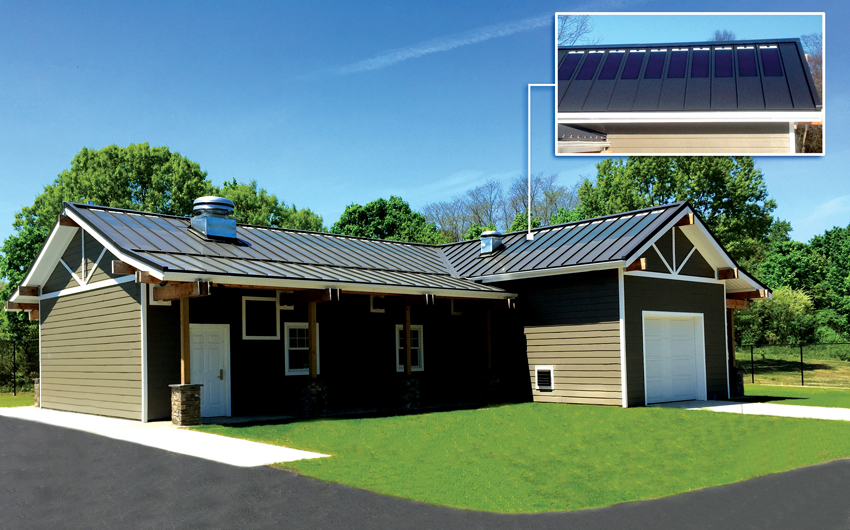
Thin-film photovoltaic laminates integrate with the flat pans between the standing seams of the roof.
The film is a stainless steel substrate with an ethylene tetrafluoroethylene (ETFE) protective coating. Amorphous silicon and copper indium/gallium diselenide (CIGS) technologies are used in BIPV products.
BIPVs are lightweight, flexible (which permits curving), and durable, plus they help to maintain the serviceability of the roof. Typically, they are warranted for 25 years.
From an aesthetic perspective, BIPV products are appealing because they integrate nicely with the flat pans between the standing seams of the roof. BIPV systems are used anywhere that standing-seam roofs are specified.
Crystalline Systems versus BIPV Systems
Although crystalline systems produce at a higher efficiency during midday, BIPV systems are better able to produce energy in diffuse, low light. As a result, they can pick up three spectrums of light, whereas crystalline systems only pick up one. This also means BIPV systems produce energy earlier in the day and end production later in the day.
However, BIPV laminates are separated by the seams of a standing-seam roof. Therefore, they require roughly twice the square footage of available rooftop space to design the same size system as crystalline panels.
All of this means that it is difficult to make apples-to-apples comparisons. The best approach is to explore the options on a case-by-case basis centered on project criteria.
LEED v4: Potential Contribution of Photovoltaics
- Integrative Process (1 point)
- Minimum Energy Performance (prerequisite)
- Optimize Energy Performance (up to 18 points)
- Renewable Energy Production (up to 3 points)
- Innovation (up to 5 points)
Conclusion
Working with the forces of nature, designing semi-passive systems of stunning simplicity is perhaps the most cost-effective and operationally prudent path to sustainability. Energy is saved, carbon emissions are reduced, and operating and maintenance costs are almost nil.
Transpired solar collectors are a cost-effective means to improve ventilation and indoor air quality while reducing energy consumption and achieving sustainable building design objectives. Cool roofing is gaining in popularity because it can help reduce peak cooling energy demands in buildings and mitigate the urban heat island effect. Above-sheathing ventilation minimizes the effect of condensation between the roof layers and creates energy savings by reducing air-conditioning costs in the summer and adding insulation value during the winter. Metal roofs are an excellent platform for photovoltaic (PV) systems, as they offer recyclability, strength, and weather resistance, as well as a longer service life compared to other materials.
Due to the availability of recycled and recyclable metal components, as well as their innate longevity, the savvy designer, engineer, contractor, and building facilities manager will consider these innovative yet straightforward building envelope systems for their projects.
Kathy Price-Robinson has written about building design and construction for her entire career. www.linkedin.com/in/kathypricerobinson
END NOTES
1,2“Transpired Collectors (Solar Preheaters for Outdoor Ventilation Air).” Federal Technology Alert. National Renewable Energy Laboratory. U.S. Department of Energy. April 1998. Web. 9 April 2020.
3Renewable Energy Tax Credits. ENERGY STAR. U.S. Department of Energy. Web. 7 April 2020.
4Roberts Jr., Glenn. “Can’t Take the Heat? Cool Walls Can Reduce Energy Costs, Pollution.” Lawrence Berkeley National Laboratory. 9 July 2019. Web. 7 April 2020.
5Rosado, Pablo J. and Levinson, Ronnen. “Potential benefits of cool walls on residential and commercial buildings across California and the United States: Conserving energy, saving money, and reducing emission of greenhouse gases and air pollutants.” Energy and Buildings. 15 September 2019. Web. 7 April 2020.
6Miller, William; Desjariais, Andre; and Kosny, Jan. “A Compilation of Home Energy Assessments for Cool Roofs, Above-Sheathing Ventilation, Radiant Barriers, and Other Attic Strategies.” Thermal Performance of the Exterior Envelopes of Whole Buildings, 11th International Conference. January 2010. Web. 7 April 2020.
7“Retrofit Roofs Offer Design, Environmental, and Financial Benefits in New and Existing Construction.” Metal Construction Association. August 2016. Web. 7 April 2020.











